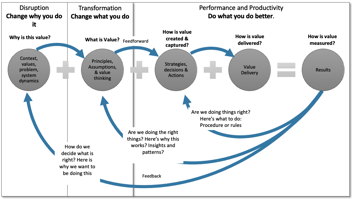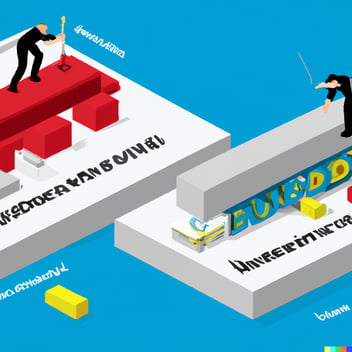Ground Control to Major TOM: Why It's Time to Rethink Form and Function in Business
I've had a few conversations lately regarding operating models (or TOM - Target Operating Model). Just to be clear, an operating model focuses on the FORM that a business takes to deliver outcomes. That form is predominantly focused on structure and the behavior of that structure under certain conditions. More specifically the mix of the structural components in different ways facilitates the emergence of new behavior with, hopefully, a significant improvement.
So which comes first, function or form? This debate is as old as the conversation around profit vs purpose, centralization, or decentralization. I believe the issue lies in taking a form-before-function mindset. You see this typically in organizational restructures, transformations, spills, and fills, etc. The focus of leadership typically looks at changing the structure of the business to improve outcomes, and this usually involves people. So, sweep the decks clean and bring on some new people to help you achieve the outcomes you're looking for.
A form-first approach is all about understanding your people, skills, and roles, and then fitting the work INTO this structure. Annual budgeting process, anyone? The bigger the team, the bigger your budget allocation and the more power you have. Now you just need to find work to fit into your structure to keep your people busy. This is a flawed mindset, and it appears to be an ongoing mindset, as I've personally seen very little change in this way of working.
A similar occurrence happened with a major banking client. The CEO's vision was to make the entire group agile in their thinking and delivery. In swoops a top-four consulting firm with an 18-month program before any value is delivered—oh, the irony. These highly paid consultants essentially took the scaled agile framework and smashed a Target Operating Model (TOM) into it, not the other way around. They focused on the form, structure, people, roles, and responsibilities, not the work that needed to be done. In other words, they bent a work-based model into a resource-based model. Needless to say, the New Way of Working (NWOW) outcome was, in fact, NO WAY OF WORKING.
Another client followed a function-before-form approach. They separated the function from the form and started with the function. They designed the business architecture needed to deliver outcomes and THEN figured out the best form to support the functions. This works especially well when you're dealing with a new department, subsidiary, or organization, and you have a bit of a greenfield mandate. I remember doing this for the electoral commission in South Africa. We had a complete greenfield opportunity to design and create an organization from scratch to facilitate the democratic elections. What a fascinating journey it was to first understand the work and then to design the best form that the business needs to take to deliver something as important as the democratic process.
A simple analogy might help. Think of the organization as a bathtub. It's taken a number of years for this bathtub to fill up with knowledge, skills, processes, and workarounds. It would take the same amount of years to drain the bathtub, all things being equal. In principle, If you want to change the organization, you would need to either change how the bathtub fills up or how it drains.
Doing a spill and fill is equivalent to replacing the bathtub. Think of the bathtub as a stock that stores value like knowledge capital, skills, and relationships. Replacing the bathtub would result in a huge absence and removal of these stores of value. I don't believe removing these stores is the answer; I believe altering the flows into these stocks is where the true essence lies. It's a FUNCTIONAL discussion. Flows are more aligned with "function" than "form." The focus is on how value is added to and taken away from the bathtub. So going on a training course increases your skill whilst not applying that learning within a certain time period, reduces that skill, and its associated value to the ecosystem. The flows describe what is happening in the system, such as how resources are moved, used, or transformed. They represent the dynamic aspects of the system—how things change over time due to interactions between different elements.
What if you could avoid experimenting with change directly on your staff, projects, knowledge, etc, and instead experiment with both function and form with limited effort? What if you could mimic my bathtub and its flows, and experiment with ways that could change these flows? A digital twin, where you could play with function and form aspects to test behavior on the entire system of the business, not just one value stream at a time or one process area at a time, could be the answer.
This level of experimentation with the complexity of the business is missing. And so, decision-makers follow a shifting-the-burden pattern and push complexity downstream to middle management and delivery teams, who then solve it in their small fiefdoms without clearly understanding how the entire system works together. The results are unintended consequences, vicious cycles, and repeating problems that never quite seem to go away, they just get “rebranded” in the next budget cycle.
I spent three years helping a merchant bank deal with the unintended consequences that caused a material weakness picked up in the annual audit reports. The same issue, year after year. The same advice, a different team ie. a different FORM of the business. The stock/memory of that weakness is replaced each year. My invoice is the same each year….for the same advice.
So it's time to change the mindset. Stop experimenting with actual people and their careers and livelihoods, and shift some of that experimentation into the digital space - a system dynamics digital twin. You may be surprised by the insights that can keep a lot of great people in your business, and a salary in their bank accounts. Sounds like a win-win to me.




